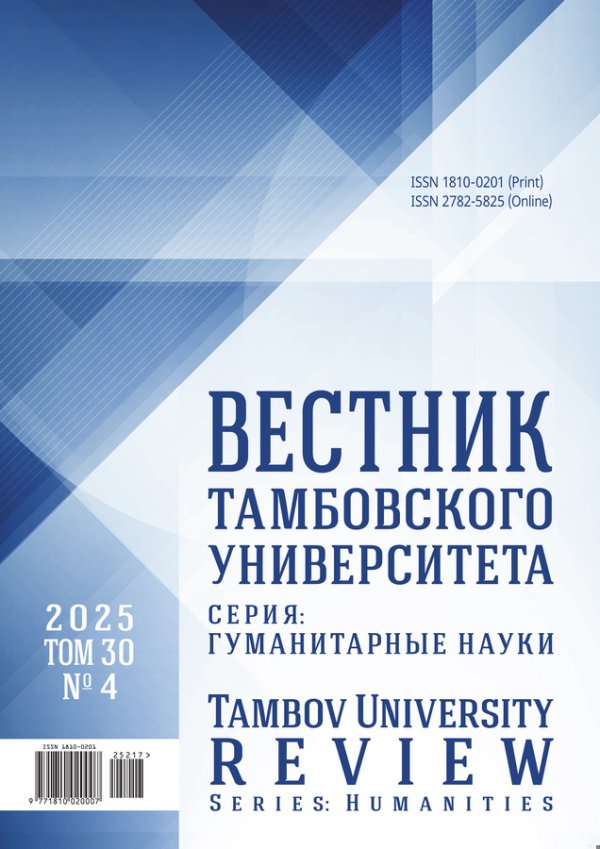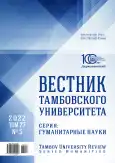Формирование карты сельских поселений русского населения Тарского уезда в XVI–XIX веках
- Авторы: Соколова Е.В.1
-
Учреждения:
- ФГБОУ ВО «Омский государственный аграрный университет им. П.А. Столыпина»
- Выпуск: Том 27, № 5 (2022)
- Страницы: 1274-1282
- Раздел: ОТЕЧЕСТВЕННАЯ ИСТОРИЯ
- URL: https://ogarev-online.ru/1810-0201/article/view/298299
- DOI: https://doi.org/10.20310/1810-0201-2022-27-5-1274-1282
- ID: 298299
Цитировать
Полный текст
Аннотация
Целью исследования явилось выявление факторов, определяющих процесс формирования карты сельских поселений Тарского уезда в XVI–ХIХ веках и этапов освоения и заселения территории. Среди факторов выделена политика государства в области заселения Сибири в целом и Тарского уезда в частности и стремление крестьян осваивать новые территории в поисках добротных пашенных земель. Выявлены следующие этапы появления новых русских деревень на карте уезда: конец XVI века – начало XVII века, когда главной задачей была оборона границ территории; XVII – первая половина XIX века, когда рост численности сибирского населения повлек за собой увеличение потребности в хлебе и, как следствие, потребность в освоении новых земель; вторая половина XIX века, когда появление новых населенных пунктов является результатом переселенческой политики государства. Проанализированы различные точки зрения на появление на карте новых деревень, их размещение относительно старожильческих территорий. Результаты исследования будут полезны и интересны ученым, занимающимся изучением вопросов сельской истории, педагогам образовательных организаций всех уровней образования и широкому кругу читателей, увлеченных историей Отечества.
Ключевые слова
Об авторах
Е. В. Соколова
ФГБОУ ВО «Омский государственный аграрный университет им. П.А. Столыпина»
Автор, ответственный за переписку.
Email: lev-15@mail.ru
ORCID iD: 0000-0002-1069-0389
кандидат исторических наук, доцент, заведующий кафедрой гуманитарных, социально-экономических и фундаментальных дисциплин
644008, Российская Федерация, г. Омск, Институтская пл., 1Список литературы
- Гербер О.А., Коровушкин Д.Г. Политика раскрестьянивания и трансформации поселенческой сети аграрных переселенцев в Омском Прииртышье: на примере латышей, немцев и эстонцев // Вестник Омского университета. Серия: Исторические науки. 2021. Т. 8. № 3 (31). С. 176-188. https://doi.org/10.24147/2312-1300.2021.8(3).176-188
- Писканова Т.Н., Пуляевская Е.В. Формирование системы сельского расселения Восточной Сибири в период «Столыпинской реформы» (на примере Иркутской губернии) // Градостроительство. Теория, практика, образование: материалы 4 Всерос. науч.-практ. конф. Иркутск, 2022. С. 331-339.
- Усольцева О.В. Сельская поселенческая сеть Томской области (1940–1980-е гг.). Томск: Демос, 2018. 268 с.
- Татарникова А.И., Загороднюк Н.И. Сеть поселений Кондинского района Уральской области по данным переписи 1926 г. // Genesis: исторические исследования. 2017. № 10. С. 43-54. https://doi.org/10.25136/2409-868X.2017.10.24105
- Пислегин Н.В. Расселение русского крестьянства на территории современного Кизнерскогого района Удмуртии в XVII – первой половине XIX в. // Историко-культурное наследие народов УралоПоволжья. 2021. № 2 (11). С. 23-28. https://doi.org/10.15350/26191490.2021.2.22
- Белоусов С.С. Влияние железных дорог на развитие поселенческой сети в Астраханской губернии (последняя четверть XIX – начало ХХ в.) // Былые годы. 2020. № 57 (3). С. 1264-1269. https://doi.org/10.13187/bg.2020.3.1264
- Жиров Н.А. Развитие крестьянского хозяйства и демоэкологические процессы в Орловской губернии во второй половине XIX – начале ХХ в. // Вестник Тамбовского университета. Серия: Гуманитарные науки. 2020. Т. 25. № 189. С. 168-174. https://doi.org/10.20310/1810-0201-2020-25-189-168-174
- Ерин П.В. Община в сельском самоуправлении русской деревни до и после 1917 года (на материалах Тамбовской губернии) // Вестник Тамбовского университета. Серия: Гуманитарные науки. 2020. Т. 25. № 189. С. 175-180. https://doi.org/10.20310/1810-0201-2020-25-189-175-180
- Соколова Е.В. Освоение территории Колосовского района Омской области в XVI – начале XX в. // Вестник Кемеровского государственного университета. 2017. № 4 (72). С. 99-104.
Дополнительные файлы










